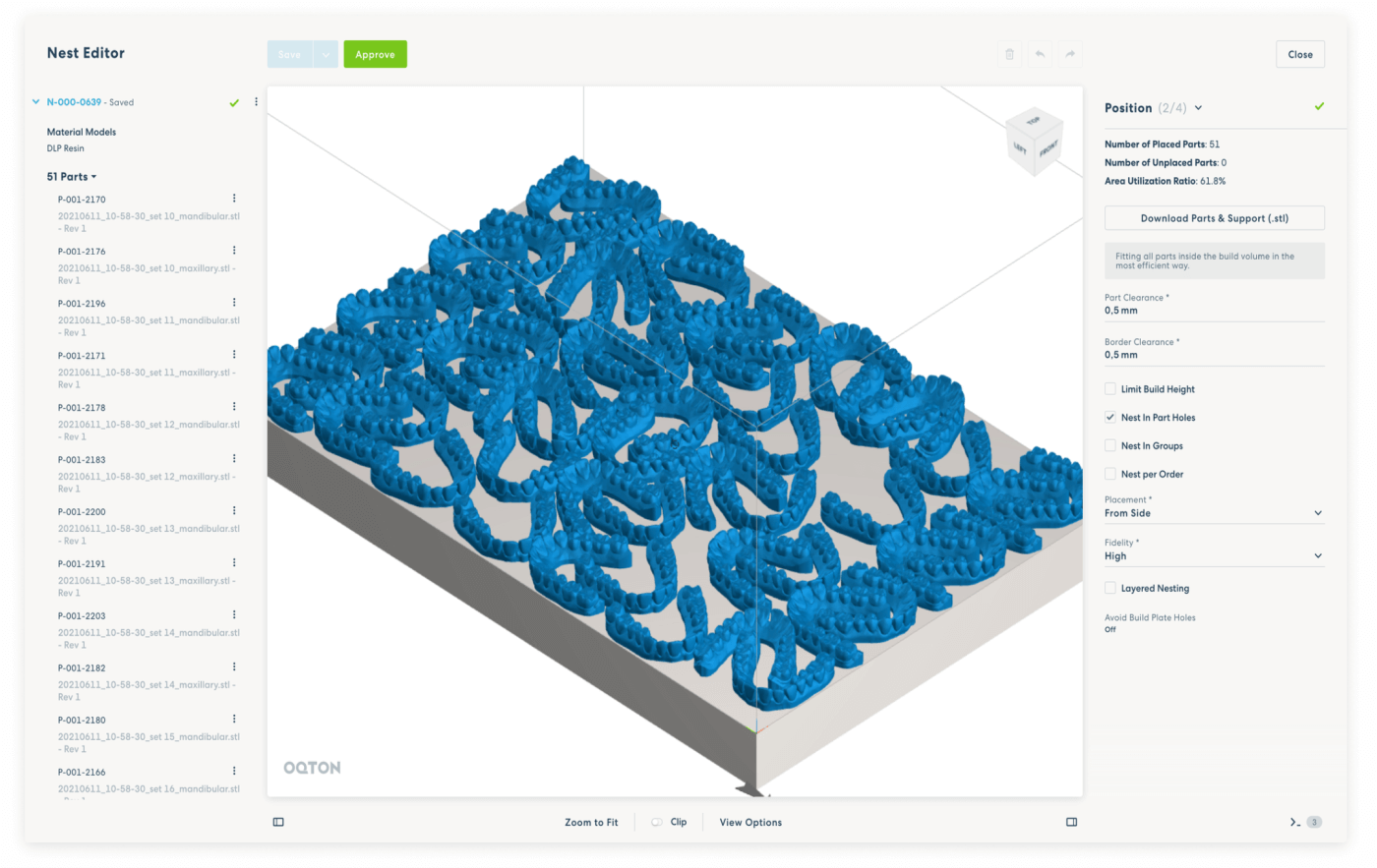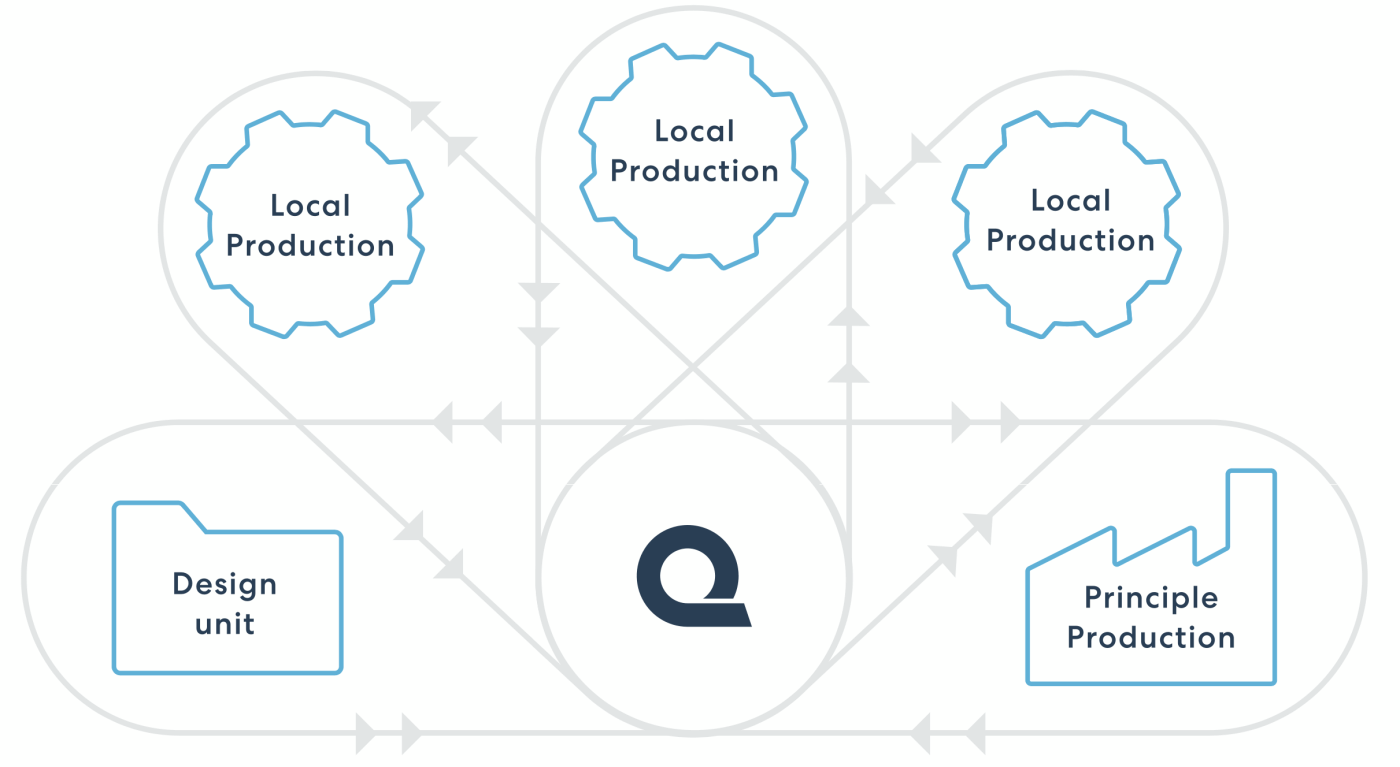How to connect your clear aligner production system
Clear aligners are a true mass customisation success story with unique parts being produced at large volumes. A treatment plan for a single patient easily includes upwards of a dozen aligners, produced in numerous stages, from printing a resin model through thermoforming and trimming. But to succeed, clear aligner businesses need an efficient and flexible production. Oqton’s Manufacturing OS gives them all the tools they need to achieve this in one place.
The future looks bright for the clear aligner market. Customer demand is high and predicted to grow at about 20% a year for the rest of the decade. Patents are expiring, which has opened the gates to a wave of new entrants, from small start-ups to large dental players.
At the same time, these new entrants are pushing down the prices and driving up innovation. On the manufacturing side, we find that clear aligner production involves a high volume of different parts created in a multi-stage process that must be entirely tracked and traceable. One aligner requires printing a 3D model, thermoforming a plastic sheet, trimming, polishing and labelling the aligners and finally correctly grouping and packing them.
And the technologies used in clear aligner production are rapidly evolving, so companies need to ensure that they can easily integrate new hardware, like laser-based aligner trimming or robotisation, into their existing setup.
These challenges reveal a need for a flexible, end-to-end solution that will streamline clear aligner production and allow businesses to maintain profitability. To address these issues, we’ve created a unified platform called a Manufacturing OS that offers simple workflows for all the production technologies – metal 3D printing, resin 3D printing, and CNC milling.
What is a Manufacturing OS?
The Manufacturing OS is a unique and integrated system that combines the capabilities of a Manufacturing Execution System (MES) to allow you to plan, track and analyze everything on the shop floor, with the Industrial Internet of Things (IIoT) data about, and Computer-aided Manufacturing (CAM) ability to generate files for 3D printers or milling machines.
To increase the efficiency of your dental production and decrease reliance on staff, we’ve developed AI-based automation of CAM workflows from order to production. Any manual changes to data preparation are recorded in Oqton, traced and can be applied to future jobs.
Oqton is entirely cloud-based and accessible on a web browser from anywhere, a laptop, a tablet or even a phone. If an organization has multiple production sites, staff can log into the same platform and work on the same files from different locations.
How does the Manufacturing OS support a clear aligner production?
1. Automated data preparation and nesting assistant for 3D printing
Oqton’s smart automation of data preparation is helping radically reduce reliance on human input and achieve significant time savings. The Manufacturing OS takes the helm from the moment 3D geometries are uploaded to the software, and automates the following steps:
- Import & healing. Oqton offers fully automated file conversion and mesh healing.
- Part orientation. 3D aligner models are automatically oriented for optimal build time and surface quality.
- Hollowing. To reduce material use, you can use an automated hollowing feature.
- Part labelling. For easier sorting and full traceability, you can automatically apply labels based on file names or part count.
- Support generation. The Manufacturing OS automatically generates supports which will be minimal and easy to remove.
- Nesting. Aligner models are automatically nested in high density for maximal machine productivity.
- Slicing and hatching. A slice file is automatically generated for a selection of machines.
Nesting the correct patient cases together for each build is an important way of maximizing a 3D printer’s productivity and minimizing time spent on sorting models in post-processing. We’ve developed a Nesting Assistant that takes into account the needs and preferences of your production.
You can decide to always keep all the models of a single patient together or split them over multiple builds if nesting density is your priority. You can specify to only create full nests or with a minimal density, and the software will create a nest as soon as enough parts are available. You can also have patient cases nested based on import date (first in, first out), due date or all equal priority.
 A print-ready nest is generated fully automatically.
A print-ready nest is generated fully automatically.
2. Connect all the machines in your clear aligner production
Printing of 3D models is just one element in the clear aligner ecosystem, and the Manufacturing OS offers similar flows for other processes that can be automated and act as the central part of your production.
A novel technology gaining ground in the clear aligner space are machines for automated thermoforming.
With the help of a built-in camera, the machine identifies the model’s label, the Manufacturing OS retrieves the information that needs to be laser marked on the final clear aligner and sends it to the machine to mark the part, all the while keeping track of where each part is in production.
In the case that a production facility uses a CNC machine for aligner trimming, the Manufacturing OS generates the necessary toolpaths, or you can integrate 2D label printers to automatically create shipping labels.
In addition, you can connect an ERP system to our Manufacturing OS, which will allow you to automatically push design files and retrieve production statuses.
3. Deep integration with various brands of machines
Oqton’s software is hardware-neutral and integrated with many machine brands currently on the market. For clear aligners, we can integrate with printers from Prodways, Carbon, HP, Nexa3D, and 3D Systems resin printers among others, which gives you the peace of mind that you can easily generate the correct files. We also work with Hamer machines for smooth automated thermoforming.
To deepen this integration, we’ve made it possible to capture more information from the machines or allow the remote start of printing without an operator nearby. Because the platform is cloud-based, we can also provide easy technical support.
4. MES capabilities to plan, monitor & track your production
Clear aligner companies are using the Manufacturing OS as the heart of a manufacturing ecosystem that allows them to keep track of the many stages of production and adapt when they need to. Thanks to Oqton, they have digitized your production planning, configured production routes and scheduled steps for all machines in one place.
A shining example of this is Prodways’s fully optimized and validated ecosystem. The 3D printer and material manufacturer has partnered with the leading companies in the digital dentistry space to give their customers a turnkey clear aligner solution. Prodways integrates machines and software for scanning, data preparation, treatment design, 3D printing, thermoforming, laser marking and trimming, and monitoring into a single solution, saving clear aligner companies time normally spent on getting production off the ground.

The last but crucial advantage of our Manufacturing OS is that it gives you traceability with a full revision history. You can track material batches, consumption, build plates, tools and resources, giving you full QMS capabilities. This information can be presented as dynamic reports with integrated NFC and QR codes for easy shop floor access to the online version.
Oqton software provides automation for a range of dental workflows spanning crowns, bridges, aligners, models, and RPDs. Find out how we support digital dentistry or send us a message for more information!
 Benoît Soete
Benoît Soete